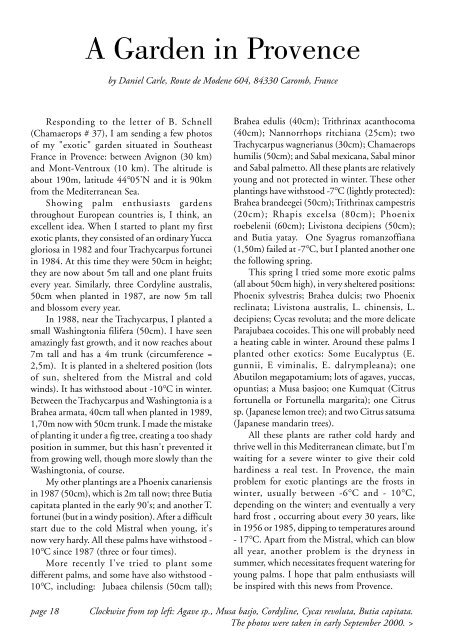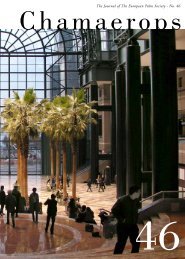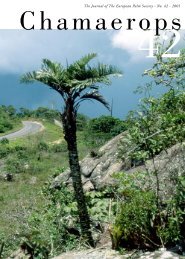Download - The European Palm Society
Download - The European Palm Society
Download - The European Palm Society
Create successful ePaper yourself
Turn your PDF publications into a flip-book with our unique Google optimized e-Paper software.
A Garden in Provenceby Daniel Carle, Route de Modene 604, 84330 Caromb, FranceResponding to the letter of B. Schnell(Chamaerops # 37), I am sending a few photosof my "exotic" garden situated in SoutheastFrance in Provence: between Avignon (30 km)and Mont-Ventroux (10 km). <strong>The</strong> altitude isabout 190m, latitude 44°05'N and it is 90kmfrom the Mediterranean Sea.Showing palm enthusiasts gardensthroughout <strong>European</strong> countries is, I think, anexcellent idea. When I started to plant my firstexotic plants, they consisted of an ordinary Yuccagloriosa in 1982 and four Trachycarpus fortuneiin 1984. At this time they were 50cm in height;they are now about 5m tall and one plant fruitsevery year. Similarly, three Cordyline australis,50cm when planted in 1987, are now 5m talland blossom every year.In 1988, near the Trachycarpus, I planted asmall Washingtonia filifera (50cm). I have seenamazingly fast growth, and it now reaches about7m tall and has a 4m trunk (circumference =2,5m). It is planted in a sheltered position (lotsof sun, sheltered from the Mistral and coldwinds). It has withstood about -10°C in winter.Between the Trachycarpus and Washingtonia is aBrahea armata, 40cm tall when planted in 1989,1,70m now with 50cm trunk. I made the mistakeof planting it under a fig tree, creating a too shadyposition in summer, but this hasn't prevented itfrom growing well, though more slowly than theWashingtonia, of course.My other plantings are a Phoenix canariensisin 1987 (50cm), which is 2m tall now; three Butiacapitata planted in the early 90's; and another T.fortunei (but in a windy position). After a difficultstart due to the cold Mistral when young, it'snow very hardy. All these palms have withstood -10°C since 1987 (three or four times).More recently I've tried to plant somedifferent palms, and some have also withstood -10°C, including: Jubaea chilensis (50cm tall);Brahea edulis (40cm); Trithrinax acanthocoma(40cm); Nannorrhops ritchiana (25cm); twoTrachycarpus wagnerianus (30cm); Chamaeropshumilis (50cm); and Sabal mexicana, Sabal minorand Sabal palmetto. All these plants are relativelyyoung and not protected in winter. <strong>The</strong>se otherplantings have withstood -7°C (lightly protected):Brahea brandeegei (50cm); Trithrinax campestris(20cm); Rhapis excelsa (80cm); Phoenixroebelenii (60cm); Livistona decipiens (50cm);and Butia yatay. One Syagrus romanzoffiana(1,50m) failed at -7°C, but I planted another onethe following spring.This spring I tried some more exotic palms(all about 50cm high), in very sheltered positions:Phoenix sylvestris; Brahea dulcis; two Phoenixreclinata; Livistona australis, L. chinensis, L.decipiens; Cycas revoluta; and the more delicateParajubaea cocoides. This one will probably needa heating cable in winter. Around these palms Iplanted other exotics: Some Eucalyptus (E.gunnii, E viminalis, E. dalrympleana); oneAbutilon megapotamium; lots of agaves, yuccas,opuntias; a Musa basjoo; one Kumquat (Citrusfortunella or Fortunella margarita); one Citrussp. (Japanese lemon tree); and two Citrus satsuma(Japanese mandarin trees).All these plants are rather cold hardy andthrive well in this Mediterranean climate, but I'mwaiting for a severe winter to give their coldhardiness a real test. In Provence, the mainproblem for exotic plantings are the frosts inwinter, usually between -6°C and - 10°C,depending on the winter; and eventually a veryhard frost , occurring about every 30 years, likein 1956 or 1985, dipping to temperatures around- 17°C. Apart from the Mistral, which can blowall year, another problem is the dryness insummer, which necessitates frequent watering foryoung palms. I hope that palm enthusiasts willbe inspired with this news from Provence.page 18Clockwise from top left: Agave sp., Musa basjo, Cordyline, Cycas revoluta, Butia capitata.<strong>The</strong> photos were taken in early September 2000. >










